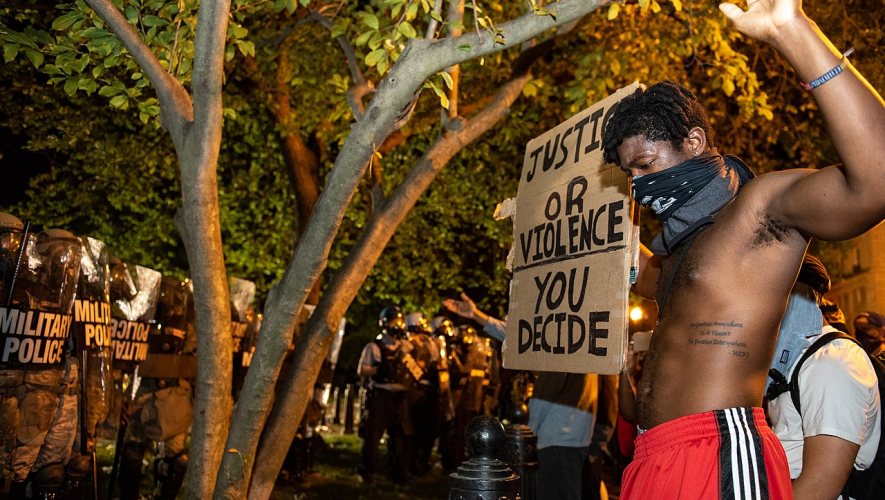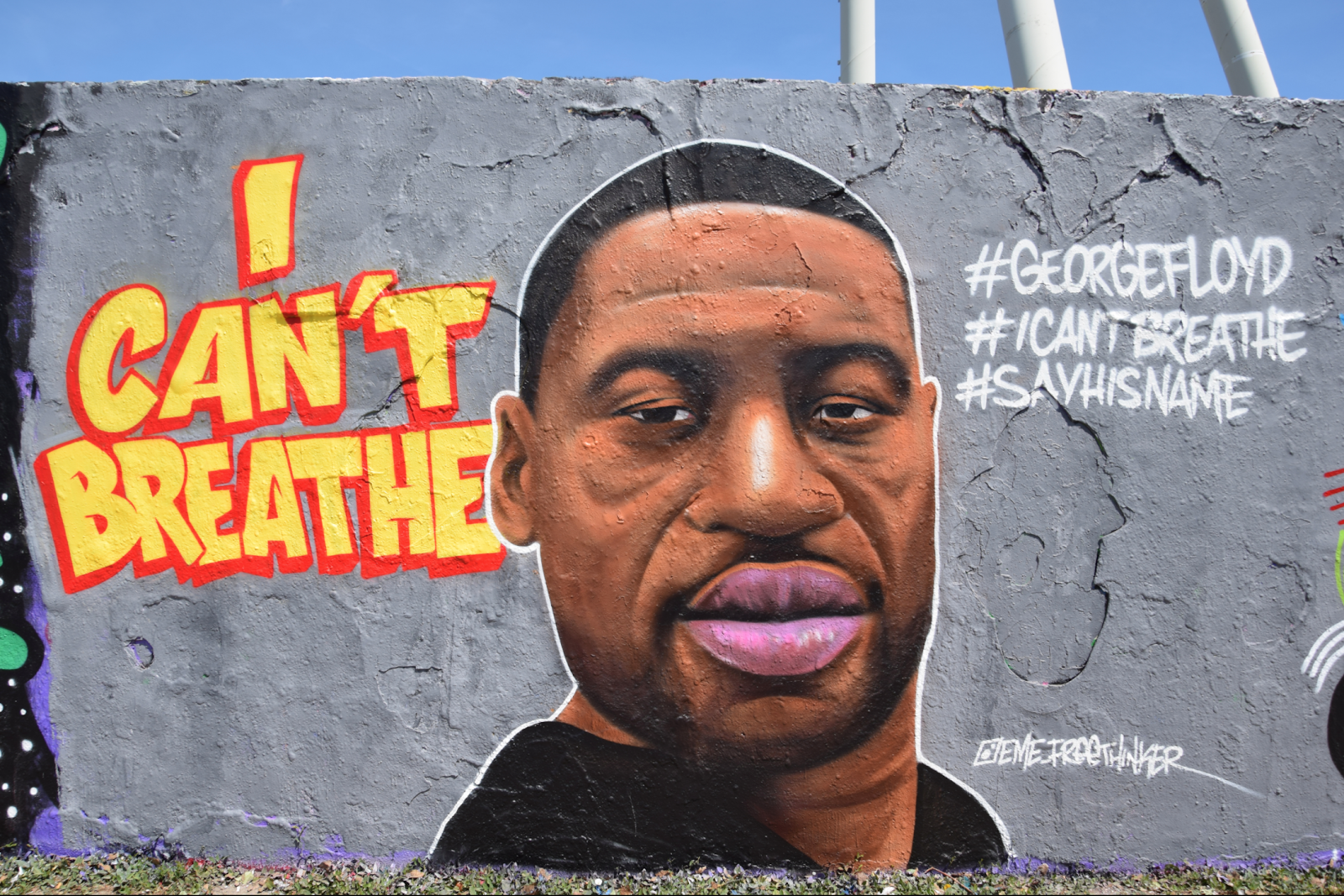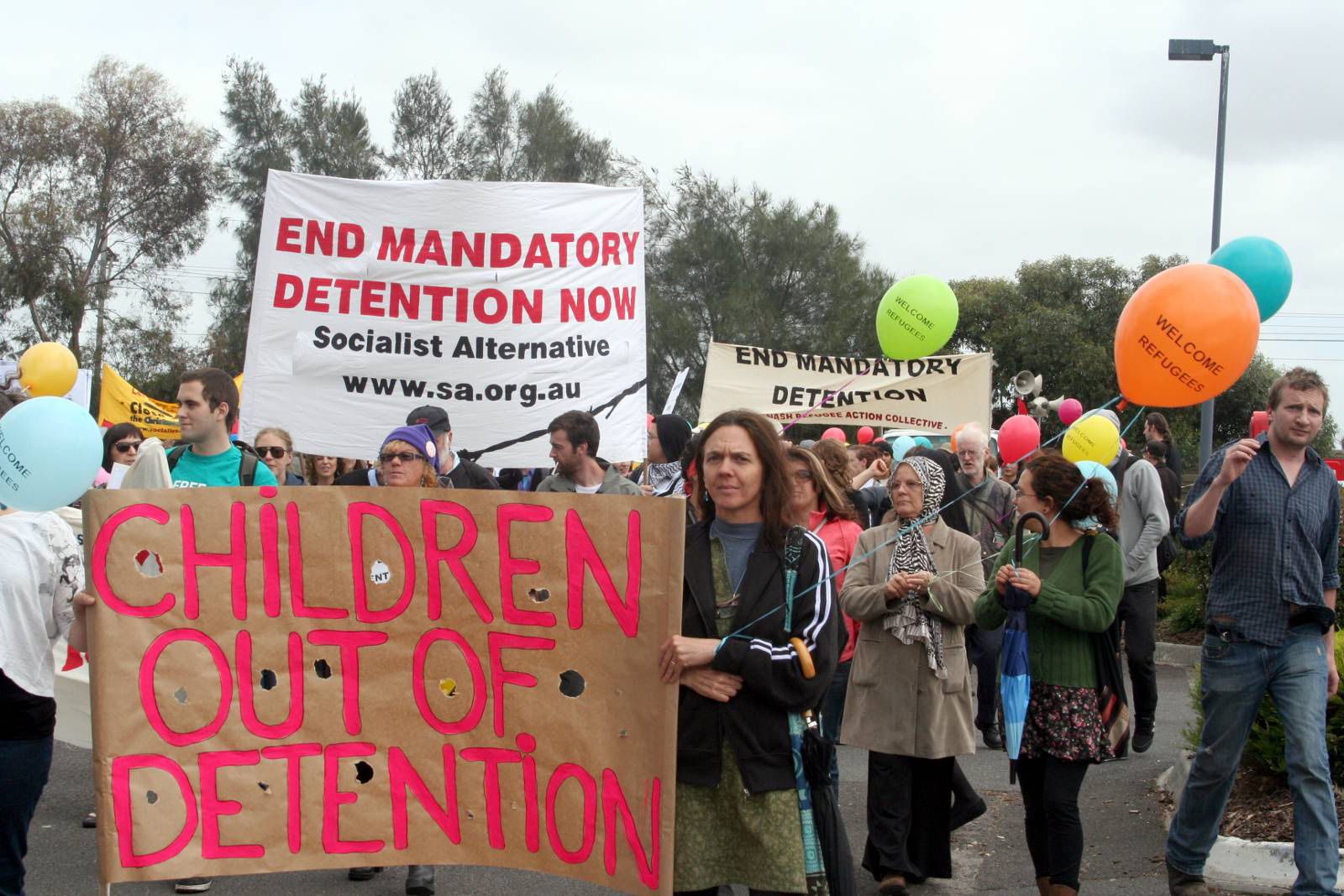What you feel when you see a police officer depends entirely on who they are to you.
For the privileged white protesters who donned military gear, brandished guns, and marched uninhibited into the Michigan State Capitol on April 30, police officers were public servants to be shouted at on the way into the building. Amid the worst pandemic in a century, the demonstrators were comfortable conducting an armed protest of a common-sense stay-at-home order, and they were comfortable doing it unmasked. Because masks make breathing just a tad harder.
George Floyd couldn’t breathe at all. For nearly nine minutes, including three after Floyd was unresponsive, white Minneapolis police officer Derek Chauvin forced his knee into Floyd’s neck while his fellow officers stood idly by. Their unconscionable indifference to a Black man’s life showed just how little they feared accountability. For Floyd and many who look like him, police officers are oppressors.
Since then, Americans have flooded the streets to protest the systematic discrimination and brutality Black Americans face at the hands (and weapons) of police. By focusing on the methods of the protests as a means to reframe and recontextualize them, critics can distract the public from the issues driving the protests.
This cannot be allowed to happen.
Framing Protests, Framing Protesters
We could have seen this coming.
During the 2016 NFL preseason, quarterback Colin Kaepernick started kneeling during the national anthem to protest racial injustice and oppression. “I am not going to stand up to show pride in a flag for a country that oppresses Black people and people of color,” he said. “There are bodies in the street and people getting paid leave and getting away with murder.”
During the 2017 season, many players kneeled for the same reasons. A chorus of critics—with a predictable conductor—framed the protests as anti-flag, anti-anthem, anti-troop, and anti-America.
“Wouldn’t you love to see one of these NFL owners,” President Trump barked, “when somebody disrespects our flag, to say, ‘Get that son of a bitch off the field right now, out. He’s fired. He’s fired!’”
The kneeling players repeatedly clarified that they were trying to raise awareness of police brutality and racial injustice, not disrespect the country, its flag, or its troops. But their critics ignored them. Perhaps they didn’t understand what the players were protesting. Perhaps they didn’t care. Or perhaps they realized that they had to make the protests about patriotism because they couldn’t win an argument about racial injustice.
The critics succeeded. Proponents were left defending the kneeling itself as the racism underlying the protest faded into an afterthought. NFL teams have blackballed Kaepernick ever since, even though many teams could use him. Fan pressure dissuaded the few teams known to have considered signing him. The framing of his protest cost the socially conscious, philanthropic Kaepernick a job in a league that has repeatedly welcomed violent offenders.
When civility leads to death, revolting is the only logical reaction.
The cries for peace will rain down, and when they do, they will land on deaf ears, because your violence has brought this resistance.
We have the right to fight back!
Rest in Power George Floyd
— Colin Kaepernick (@Kaepernick7) May 28, 2020
Those opposing the ongoing protests against police racism are employing the same framing tactic. Once public focus shifts to the method of protest, the substance fades away.
Journalists can aid or inhibit this shift by choosing whether to emphasize the protest or the issue, as well as which speakers they amplify. Emphasizing disruption over the grievances of protesters reduces public support.
One study of protest coverage in Texas found that coverage generally focused on spectacle and drama over substance. Just as egregious was its finding that the press elevates some advocates over others. For protests related to Trump, immigration, women’s rights, and the environment, roughly half the coverage provided substantial information about the issues driving the protest. For protests against anti-Black racism and the building of the Dakota Access Pipeline on Native American land, less than a quarter of the coverage did so.
Some conservative commentators have reduced Floyd’s murder to an isolated incident, then focused on what they perceive as unjust destruction and looting of property. They have called the demonstrators “criminal mobs” and lambasted them for “exploiting” Floyd’s murder. President Trump’s initial tweets denigrated protesters as “thugs,” threatened violence against them, ignored their grievances, and focused on fires and looting.
This is not to say that fires and looting aren’t worth covering. But it’s also worth discussing who is doing those things.
In Oakland, California, most of the destruction has been linked to young white men. One group—wearing all black to indicate they were organized—trashed property and fled when officers arrived, leaving people of color to suffer the consequences. In San Diego, white supremacists staged a protest to lure supporters of Black Lives Matter; BLM found out and urged their supporters not to attend. In Eugene, Oregon, undercover cops encouraged protesters to break into Target. In Reno, Nevada, white protesters amplified tensions between police and BLM protesters; they donned black, armed themselves with baseball bats and rocks, and started smashing city hall. In Pittsburgh, a peaceful protest escalated after a white man unaffiliated with protesters damaged a police car. In Brooklyn, white antagonists burned a police van. They were arrested for arson, but the damage was done—it sparked the arrest of two hundred others.
This goes far beyond protesters ignoring the wishes of Black protest leaders. This is the white opponents of those leaders breaking laws to smear the protests and drain their public support. This law-breaking obscures the truth: most protests have been largely peaceful, consisting only of marching, chanting slogans, and repeating the names of those murdered by officers.
It also obscures police officers’ role in perpetrating and exacerbating protest violence. Research has consistently shown that escalation of police force—including mass arrests, weapons, and tear gas—causes more violence, not less. Disproportionate police force can turn a peaceful protest into a violent one. Showing up in tactical gear doesn’t help either.
We don’t yet know how much law-breaking is actually being done by anti-racist protesters. But even if we assume that some of it is their doing, there’s still plenty of context that their critics are omitting.
Time, Place, and Manner
In 1773, when a group of revolutionaries boarded British merchant ships and tossed tea chests into Boston Harbor to protest taxation without representation, they didn’t do it to make the British East India Company comfortable. They didn’t do it to make the British Parliament comfortable. They didn’t do it to make King George III comfortable. The protest, lionized in American culture and lauded in schools, was designed to make the ruling powers uncomfortable.
The Boston Tea Party did what the anti-racism protests are doing and what all protests do. They disrupt. They cause discomfort. They do it in public where everyone has to watch. There is never a “right” time or way to protest because protests inherently oppose the established order.
They’re not asking for permission. They’re demanding rights.
The majority doesn’t get to decide how marginalized minorities express their pain, anger, and frustration. The majority doesn’t get to decide how minorities demand change.
Those who call for law and order fail to realize that these protests are happening precisely because Black people don’t experience law and order. The resting position of Black Americans is being terrorized at the hands of those who are supposed to protect them.
It isn’t just that George Floyd was murdered. It’s that George Floyd was lynched.
Derek Chauvin lynched George Floyd right in front of us, not because he feared for his safety, but because he could, because he didn’t fear arrest and prosecution. Once you understand these protests as a response to a lynching and the unchecked police culture that allowed it, their intensity starts to make sense.
At its core, comedian Trevor Noah observed, society is a contract between people, based on the just applications of its terms to all people. If you’re a Black American watching your police officers shred that contract, what incentive do you have to maintain it? Without law enforcement upholding its end, the contract dissolves.
“Think about the unease you felt watching that Target being looted,” Noah said. “Imagine how it must feel for Black Americans when they watch themselves being looted every single day. Because that’s fundamentally what’s happening in America. Police in America are looting Black bodies.”
Yes, riots are uncomfortable. So are racism and injustice. The riots are not the problem; they are a symptom of it—the natural consequence of unanswered peaceful protest. They are, as Martin Luther King Jr. noted, “the language of the unheard.” King’s assassination sparked riots in 110 cities; within six days, the Civil Rights Act of 1968 became law.
Black Americans waited more than two centuries for whites to abolish slavery. They waited another century for whites to tear down Jim Crow. The unheard of this generation do not have that long to see the end of mass incarceration and police brutality. Anyone who can’t understand why they would resort to violence has never felt powerless.
Black Americans have little recourse against violent and discriminatory officers. Powerful police unions guarantee special rights for members accused of misconduct. Juries hesitate to second-guess officers, and prosecutors are reluctant to charge officers they work with. Police departments routinely drag their feet in addressing disciplinary practices and resist civilian review. Many fired officers are reinstated on appeal.
Changing the law is just as challenging. Trump is a symbolic and tangible barrier to nonviolent progress. His response shows that he doesn’t understand the issues underlying Floyd’s lynching and the protests. Trump urged governors to call in the National Guard and “dominate the streets.” He advocated ten-year prison sentences for protesters and encouraged authorities to shoot looters. He announced his intention to send the military into cities if mayors and governors don’t escalate law enforcement presence—an appalling notion given that soldiers are trained to kill enemy combatants, not patrol streets.
But his most visually repugnant rebuke of nonviolent protest came when Attorney General William Barr ordered federal officers to clear an area near the White House. As peaceful protesters bled and vomited from the rubber bullets and tear gas, the leader of the free world strolled across the area and posed for pictures in front of a nearby church.
Let that sink in. Federal authorities assaulted peaceful protesters to secure the president’s photo op.
Black Americans cannot picture legal change under a president who referred to armed white protesters and white supremacists as “very good” and “very fine” people, but called anti-racism protesters “thugs.”
Trump’s horrific response to anti-racism protests proves one vital thing: he feels threatened. He feels threatened as a white man of unchecked privilege and he feels threatened as the most powerful person in the country. That’s one indication, at least, that the protests are working.
The Mountaintop
In the wake of the lynching of George Floyd, America’s police could not contain these protests and their message. America’s borders couldn’t either.
Demonstrators gathered outside US embassies and consulates around the world to condemn systematic discrimination against Black Americans. Others created murals and held vigils honoring victims of police brutality, proving that support can be as simple as condemning injustice or listening to the persecuted. When the international community comes together—as it did to fight apartheid—it has the power to force change.
At the Northeastern University Political Review, we believe that our work—expressing perspectives, supporting them with evidence, and putting them into the world—is fundamental to that fight. Clear, accurate writing is the enemy of misinformation and an essential weapon against bigotry. We are committed to diversity, inclusion, and equal treatment and opportunity for everyone. We hope that Northeastern students with perspectives on racial justice will use our platform to express their ideas.
We are obligated to resist injustice. Our individual responsibilities depend on our social position, talents, and opportunities. We must empathize, inform ourselves, self-reflect, and understand the drivers of institutional racism.
We must convene and collaborate to improve our world. If you can, donate to charities that you believe in—not just the ones trending on social media. Elevate unheard voices. Vote for candidates dedicated to demilitarizing police and increasing police accountability. Call, email, and tweet your representatives to remind them that their job interviews are coming up and we’re paying attention to their résumés.
Our country is on fire. When the smoke clears and the time comes to repair and rebuild, maintaining the ideology and intensity of these protests is the only way to ensure that the new America is an improvement on the old one.







